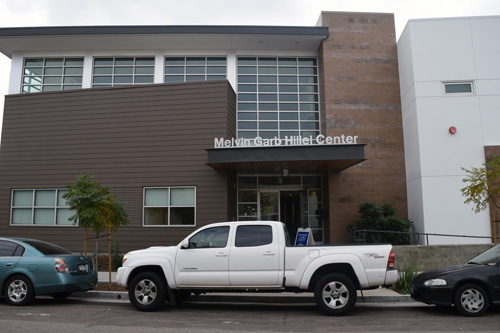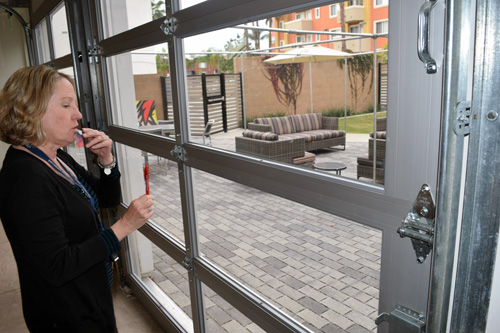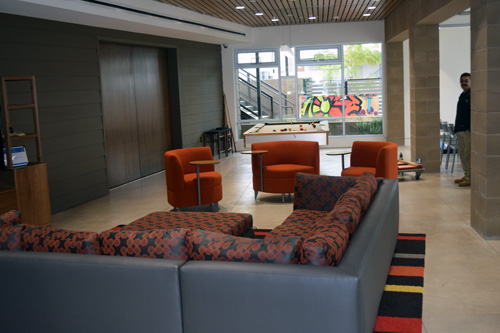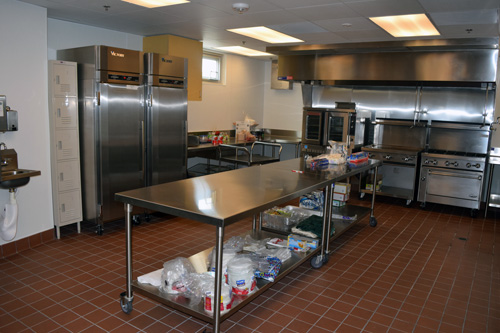
–31st in a Series–
Exit 10, College Avenue, San Diego ~ Melvin Garb Hillel Center
By Donald H. Harrison

SAN DIEGO –The Melvin Garb Hillel Center, dedicated in October 2014, is a place for Jewish students to hang out, socialize, and make Jewish connections.
Here, says Hillel’s SDSU’s campus director, Jackie Tolley, the students “engage in programs that help to fulfill Hillel’s mission to be ‘a vibrant Jewish campus presence and to involve the maximum number of university-age Jews in ways that foster a lasting commitment to Jewish life.”
The environmentally conscious, LEED-Gold certified, 10,500-square-foot building at 5717 Lindo Paseo, adjacent to the San Diego State University campus, is so attractive that other campus organizations occasionally rent its large second-story meeting room.
However, Tolley notes, there are provisos. Outside groups are not allowed to use the kitchen, unless they have a recognized kosher caterer, and they can’t bring products like pork or shellfish onto the premises.

Having such a facility, with a lounge, kosher kitchen, coffee bar, pool table, smaller meeting rooms, free wi-fi, and a patio for outdoor barbecues, is a far cry from a small, leaky house on Montezuma Road where the local Hillel got its start in the late 1970s as the Jewish Campus Center, or a later interim building not far from the present facility. The fundraising drive for the $9 million project was led by SDSU alumnus and former United Jewish Federation President Herb Solomon, The Melvin Garb Foundation made a lead gift of $2.5 million.

Tolley came to San Diego in 1977 with her husband Mark Berger, who had been hired to serve as the planning and budgeting director of the United Jewish Federation of San Diego. Having taught 5th grade in Maryland, and 8th grade in Pennsylvania, Tolley figured she probably would teach one grade or another here in California.
Rabbi Jay Miller, local director for the Jewish Campus Centers, “had moved to town the same month we did, so Jay and my husband were the two young Jewish professionals in the community, and so we knew him and his family socially,” Tolley recalled.
While Tolley was waiting for news of a teaching job, Miller suggested that because he was often elsewhere, she should keep the Montezuma house at SDSU open and meet students who should come inquiring. She recalled thinking that the job would be a nice stop gap until a teaching job came through. Her responsibilities grew exponentially in the ensuing 37 years, during which the Jewish Campus Centers morphed into Hillel of San Diego. Today, Tolley concedes happily, she is at Hillel to stay.
In a way, the arcs of her career and that of her husband crossed. Tolley got into the world of Jewish communal work and Berger got out of it. Today he serves as executive director of Partnerships With Industry, a program that finds jobs and work projects for adults with developmental disabilities.

For some students, Hillel is a touchstone—a place to come, perhaps, for a Friday night dinner, or to listen to a lecture, or to gather for a tikkun olam project somewhere out in the community. For others, Hillel is a home away from home—the place to go when there are hours rather than minutes between classes, the home where they can laugh with friends and staff in good times, or draw comfort from them in bad.
Hillel is the community agency responsible for working with the campuses in San Diego. The on-campus Jewish Student Union is affiliated with the Associated Students of SDSU. Jews at SDSU, similar to those at other universities across North America, must contend with efforts by the Students for Justice in Palestine to vilify and isolate Israel with resolutions and demonstrations calling for boycotts, divestment and sanctions against the Jewish state.
Tolley said as important as it is for Jewish students to stand with Israel, which the Hillel group takes quite seriously, members of the outside community may get the wrong idea about the reality of Jewish life at SDSU. “They don’t understand that all campuses are not undergoing the same kind of tension,” she said.
“They think because the divestment hearings get very heated that there are tensions every day, all year long. That is not the case—maybe on some campuses, but certainly not in San Diego,” she added.
Hillel, the Jewish Student Union, and another group called Students Supporting Israel (formerly Aztecs for Israel) all vigorously defend the Jewish state, she said. However, “being Jewish can’t be just about fighting,” she said. Hillel seeks to imbue in students appreciation for “all the wonderful, positive, life-enhancing things the Jewish community and Judaism have to offer.”
Indeed, there are many offerings for Jewish students both on and near campus in addition to Hillel. A few blocks north of the campus is Temple Emanu-El, which not only houses a Reform congregation but also hosts the senior citizen-oriented College Avenue Center, operated by Jewish Family Service with a kosher kitchen and plenty of opportunities for student volunteers. Within a shorter walk of the campus is the Chabad House, with many programs geared to students. South of the campus is Beth Jacob Congregation, an Orthodox synagogue.
On campus, there is a Jewish Studies Program, whose director, Prof. Risa Levitt Kohn, is also the faculty advisor to the Jewish Student Union. Hillel and Chabad alternate Friday night Shabbat dinners to which students are invited and Hillel offers student-led Shabbat services before dinner. On the afternoon of Chabad nights, Hillel has started a lunch ‘n learn program, inviting local rabbis and Jewish educators to teach over lunch.. On Rosh Hashanah afternoons, Hillel joins members of Temple Emanu-El and the Conservative Tifereth Israel Synagogue in Tashlich services at Lake Murray.
Among community members who have come to Friday night Shabbat dinners is Elliot Hirshman, the president of San Diego State University and member of the Jewish community. He and his wife Jeri also attended Hillel’s High Holy Day services and he was a speaker at the Melvin Garb Hillel Center’s dedication.
Hillel offers community service projects throughout the year, many in cooperation with Jewish Family Service. Some occur during vacation periods. For example, over a recent Spring break, Hillel House sponsored a trip to Arizona to build houses under the auspices of Habitat for Humanity. The chance of catching a Spring Training baseball game in Arizona was for some students an additional incentive.
“Especially in the west, Jewish students are not coming to campus looking to Hillel to meet their needs for kosher food, or a daily minyan,” Tolley said. “They may at some places back East, but you don’t find that on the West Coast. We are not just a synagogue on campus; we are conscious of the fact that it takes more than saying ‘Hey come to Friday night dinner’ to get students involved. They are looking for all kinds of things on campus and we have to provide a real broad cross section of activities to engage them.”
What students are looking for, “although they don’t use the language, is ‘community.’ If you ask Jewish students who walk in the door why are you here, they are not going to say, ‘Oh, I am looking for a Jewish community,’ but that is exactly what they are looking for. They will articulate that ‘I want to meet people. I want to make friends’ but the drive to find a place where you belong, that is as strong as ever. This is one place they know they can have that experience on campus.”
Tolley tallies at less than 10 percent the Jewish population of SDSU’s 30,000 student body. Of these, about 400-500 students stay in regular touch with Hillel by attending a meal or some other function, she estimated. “When we have a big barbecue at the beginning of the semester we get maybe 200 people. When we have a Shabbat dinner and services we get anywhere from 60 to 130. When we had a Mitzvah Day program it attracted about 100 students, although they were not all Jewish because with a lot of our programs we reach out to other organizations.”
Tolley’s warmest memories of her Hillel years often come from alumni who formed strong Jewish connections through Hillel at SDSU. She told of a former student who died at age 48, and a large contingent of people who attended his shiva were people he had met at Hillel 25 years before, “and they continue to support his family.”
“Could they have made friends with each other without Hillel? Maybe but to know that Hillel brought them together and their connection was so strengthened that they continue to be a source of strength and companionship for others, it is enormously gratifying.”
Hillel staff members play multiple roles in students’ lives, Tolley reflected. “There is a programmatic role. We work with student leaders to develop their leadership skills, to plan programs, to involve other students. We are their confidantes, role models, connectors—we are their life coaches as well.”
*
Next: Chabad House at San Diego State
*
Harrison is editor of San Diego Jewish World. He may be contacted at donald.harrison@sdjewishworld.com. Any comments in the space below should include the writer’s full name and city and state of residence, or city and country for non-U.S. residents.